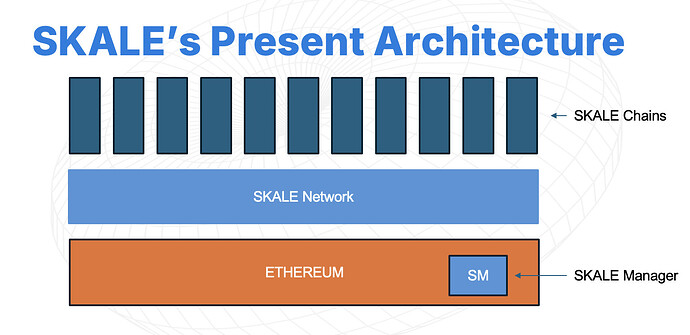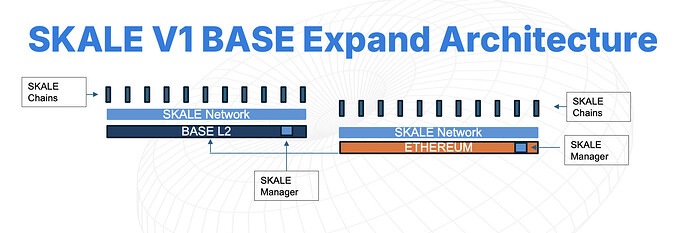Hey SKALE Community!
SKALE continues to push forward and see great success in our strongest areas. We’ve solidified our position as a top 5 blockchain in terms of daily active users and transaction volume, becoming a dominant force in Web3 gaming and a very strong player in DePin and AI.
The current model has proven our technology’s power and scalability. However, we’ve also seen a clear challenge emerge. While our network thrives with activity, the vast majority of the liquidity in SKALE’s dApp ecosystem remains on Ethereum and its burgeoning Layer 2 ecosystem. We need to attract more liquidity and financial traction in order to reach our collective goals and potential. In short, we are doing well, but can do far better.
We are already tackling this from one angle with the development of FAIR, an encrypted Layer 1 that will offer unparalleled privacy and security. But today, I want to propose an idea that is potentially a complementary path forward—a strategy to take SKALE’s proven value proposition directly to where users and liquidity already exist. This is a strategy that only SKALE can deliver due to the nature of the architecture, specifically SKALE Manager.
Also, please read knowing that this is my proposal for a potential growth avenue. I look forward to gathering thoughts and feedback from all parts of the SKALE project and community.
SKALE Expand
The SKALE Manager is a set of smart contracts that orchestrates and secures the SKALE network. These contracts live on Ethereum. This also means that the chains are directly connected to Ethereum. Stake for the network lives on Ethereum and more.
SKALE Manager is in some ways a decentralized app on Ethereum that uses the security of Ethereum to run a network of blockchains on top of it. This app does all sorts of things using smart contracts - assigns nodes to chains, re-assigns nodes, manages staking, payments, inflation, and more. Said another way, SKALE Manager is a complex system of smart contracts that can run a full blockchain ecosystem on top of another blockchain while borrowing/sharing the security from the base chain to bolster its operations.
Here is a diagram of what the network looks like today:
But we asked a simple, powerful question: Why should the SKALE Network’s growth be tethered only to Ethereum?
What if we could deploy the SKALE Manager to other ecosystems? Imagine deploying it on Base, for example. This would instantly create a new deployment of SKALE chains on top of Base, connecting every dApp in that new SKALE ecosystem directly to the deep liquidity and active user base of the Base network.
Suddenly, dApps on Base could connect to a SKALE Base Chain and offer their users:
- Gas-free transactions at lightning-fast speeds powered by a new economics model – sFuel Credits.
- Instant access to the BITE protocol, enabling encrypted transactions that prevent MEV and unlock a new world of privacy-focused use cases.
- SKALE’s x402 innovations and product suite including MachinePay.
- Instant connectivity to a world of BASE liquidity and resources.
- Applications can take advantage of SKALE’s Instant Finality on an Ethereum L2.
- Ramp from Coinbase centralized exchange to base and then SKALE BASE Chain in one click.
If this model proves successful, the SKALE Manager can be deployed on any L2 or EVM chain—from Arbitrum and Optimism to BNB Chain and beyond—with minimal configuration.
This model would let SKALE take its unique value propositions to every EVM chain without sacrificing any token value capture.
Here is a diagram of what the network would look like with SKALE Manager integrated to BASE.
If this is successful, SKALE Manager could be deployed across any EVM L1 or L2. And eventually could be deployed to other VM instances like Solana with SVM. Here is a diagram of how that could look.
Analogy – Going to the Mall: A New Strategy for Growth
Think of it this way. Imagine a large retail brand that builds a massive superstore and spends all its energy trying to get customers to visit that single location. Meanwhile, shoppers are flocking to local malls where hundreds of stores are conveniently gathered.
Instead of fighting to pull customers away from the mall, what if that brand opened a storefront inside every single mall? They don’t care if a product is sold on their original property or in a mall, as long as they are selling product and getting paid.
SKALE’s Expand strategy is similar dynamic. This strategy transforms competitors into partners. Every L2 and EVM chain needs limitless scaling and low-cost transactions. They need robust privacy solutions. By deploying SKALE, they get a technically superior solution with unmatched unit economics setting up shop right in their ecosystem. And because these deployments are permissionless, it creates a powerful, unstoppable path for expansion.
Evolving SKALE’s Economics for a Multichain Future
So, what does this mean for the $SKL token and the network’s economy? The beauty of this model is its positive impact on SKALE’s tokenomics.
- Value Capture Remains in $SKL: Apps will still pay for chain access and blockspace using SKL tokens. Whether the SKALE Manager is on Ethereum or Base, the value continues to flow into the SKL ecosystem.
- From Chain Fees to App Fees via sFuel Credits: A core part of this evolution is a shift in SKALE’s economic model. We plan to gravitate the primary revenue stream from a fixed-rate “Chain Fee” model to a more dynamic “App Fee” model. In essence, apps will pay for the amount of sFUEL (the gas in the SKALE network) they need on a pay-as-you-go basis. In essence, they are buying credits to use the blockspace in the same way a developer can buy credits to use AWS or other cloud services. This provides greater payment follow-through, improves unit economics, and aligns network revenue directly with app usage, not just the number of chains. Chains will still be able to be purchased on a “per app” basis for those that want their own chain. But the reality is that the majority of apps don’t want their own chain and prefer shared chains. Therefore the economic growth focus will be on growing the number of apps that pay per month rather than the number of chains that are paid per month.
- Each deployment reinforces $SKL’s value: every new SKALE Manager instance requires staking, node participation, and SKL payments for blockspace. The more L2s that host SKALE Managers, the greater the network effect on SKL utility and demand
The Path Forward: Test, Vote, and Grow
This is a bold new vision, and we will approach it methodically.
Our first step is to gather feedback from the community. This has been posted on the forum and we would love to hear from you.
The second step will be to test this initiative with a pilot deployment on Base. This initial test will not have any immediate impact on the chain fees or fee models in our current Ethereum-based SKALE Network and therefore won’t require governance at onset. We plan to move fast, test fast, and gather data.
Once the pilot completes, we will present the data and findings to the community and put the broader strategy to a vote. If the vote is successful, we will move forward with this multi-chain model, bringing the power of SKALE to the entire EVM ecosystem.
Please also keep in mind that this strategy is not mutually exclusive to launching FAIR. If anything, SKALE’s own Layer 1 will be even more prominent and valuable if SKALE is hundreds or thousands of times larger in terms of reach, liquidity, and value capture.
As SKALE expands across L2 ecosystems, FAIR will serve as the Foundational Blockchain Layer that ties together a world of integrated SKALE chains across various ecosystems all being run by SKALE Manager. It will be the key infrastructure anchoring security, liquidity, and privacy across the entire SKALE multichain universe. The more SKALE expands, the more valuable FAIR becomes as the nexus of encrypted compute and liquidity settlement. Once a store is successful across many malls, they end up with their own flagship store downtown.
This is our opportunity to unleash SKALE from a single ecosystem and establish it as the universal scaling and privacy layer for all of Web3. We’re incredibly excited about this path and look forward to building this future with all of you.


